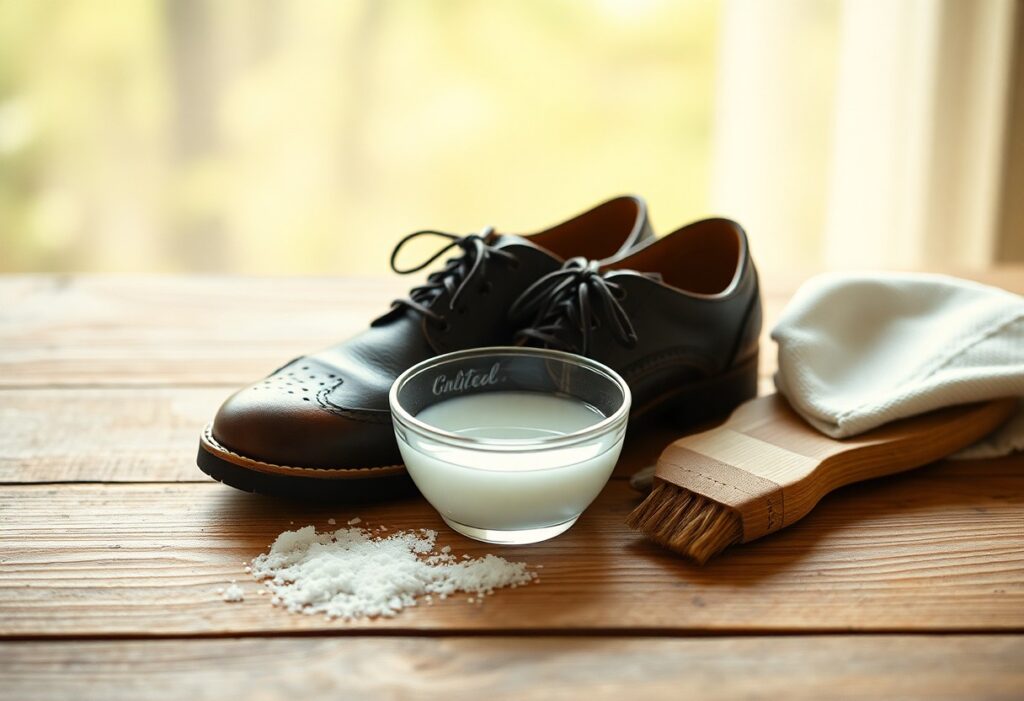
Implementing effective strategies for protecting your shoes during winter is crucial to avoid the damaging effects of road salt. In regions with severe cold, your footwear endures continuous exposure to harmful road salt, which can seriously compromise leather integrity and leave unsightly stains. The key to maintaining your shoes lies in proactive measures, starting with regular cleaning and proper care techniques. This guide will equip you with practical methods to both prevent and effectively remove salt stains, ensuring you prolong the lifespan of your shoes and keep them looking their best. Discover time-tested techniques for daily maintenance and stain removal that will protect your footwear throughout the harsh winter months.
Recognizing the Detrimental Effects of Salt Stains on Your Footwear
Understanding the impact of winter weather combined with road salt is vital to safeguarding your footwear. When shoes come into contact with salt-laden snow and slush, they are left with white residue and permanent stains that can severely affect both the aesthetic appeal and structural integrity of your footwear. Salt not only tarnishes the appearance of your shoes but can also lead to more serious issues over time, such as cracking and weakening of the materials, especially if left unaddressed. Recognizing the signs of salt damage early can help you take corrective action before it escalates into more significant problems.
Identifying Various Types of Salt Stains Based on Shoe Materials
- Leather shoes exhibit noticeable white rings and patches
- Suede material tends to develop crusty white deposits
- Canvas shoes can show a powdery white residue
- Synthetic materials may present discolored spots
| Material | Characteristics of Salt Stains |
|---|---|
| Leather | Visible white rings and dried patches |
| Suede | Crusty white deposits |
| Canvas | Powdery white residue |
| Synthetic | Discolored spots |
| Nubuck | Rough white patches |
How Salt Exposure Detrimentally Affects Leather and Other Shoe Materials
The immediate consequence of salt exposure is the dehydration of leather fibers. Salt acts as a desiccant, drawing essential moisture out from your shoes, which can lead to cracking, discoloration, and overall structural weakening of the material over time. The presence of salt can disrupt the natural oils that keep leather supple and strong, leading to a diminished lifespan for your favorite footwear. If left untreated, road salt stains can cause permanent damage, making it crucial to act quickly. The corrosive nature of salt breaks down the natural oils found in leather, compromises fiber bonds, and can eventually lead to irreversible degradation of your shoes. To protect your investment, it’s important to tackle any salt stains within 24 hours to avoid lasting damage that can ruin your footwear.
Proactive Strategies for Preventing Salt Damage to Your Shoes During Winter
To effectively shield your shoes from salt damage, it is essential to engage in proactive care strategies. Begin by applying a waterproofing treatment to your shoes before the winter season commences, and ensure regular application of protective sprays throughout the winter months. These preventive measures create a barrier against salt-laden water, helping to keep your shoes safe from direct contact with corrosive elements that can harm the leather surface.
Pre-treatment Solutions and Protective Measures to Enhance Footwear Longevity
Maximize your shoes’ defense against salt damage by applying a high-quality leather conditioner followed by a reliable waterproofing spray. It’s advisable to reapply these protective layers every 2-3 weeks during the winter months to ensure ongoing protection. For enhanced durability, consider using a wax-based protector as an additional layer of defense against the harsh winter elements that threaten your footwear.
Best Practices for Winter Maintenance to Ensure Optimal Shoe Care
Implementing effective winter shoe care techniques is essential for maintaining the integrity of your footwear. Prioritize daily cleaning and proper storage practices to protect your shoes from salt damage. Regular maintenance activities can significantly prolong the lifespan of your shoes and keep them looking pristine. Make it a habit to clean your shoes immediately after exposure to salt to prevent buildup. Utilize shoe trees when storing to maintain shape, and rotate between multiple pairs of shoes to reduce wear. Consistently apply protective spray to maintain defenses against the elements.
- Clean your shoes immediately after exposure to salt
- Utilize shoe trees when storing to maintain shape
- Rotate between multiple pairs of shoes to reduce wear
- Consistently apply protective spray to maintain defenses
Every winter day presents a risk to your shoes, so it is crucial to stay vigilant. Winter maintenance requires your consistent attention and commitment to detail. Regularly check weather forecasts for salt warning days and keep cleaning supplies readily available at home and work. Schedule regular protective treatment days into your routine and monitor the condition of your shoes on a weekly basis. Remember, prevention is far superior to dealing with damage after it occurs.
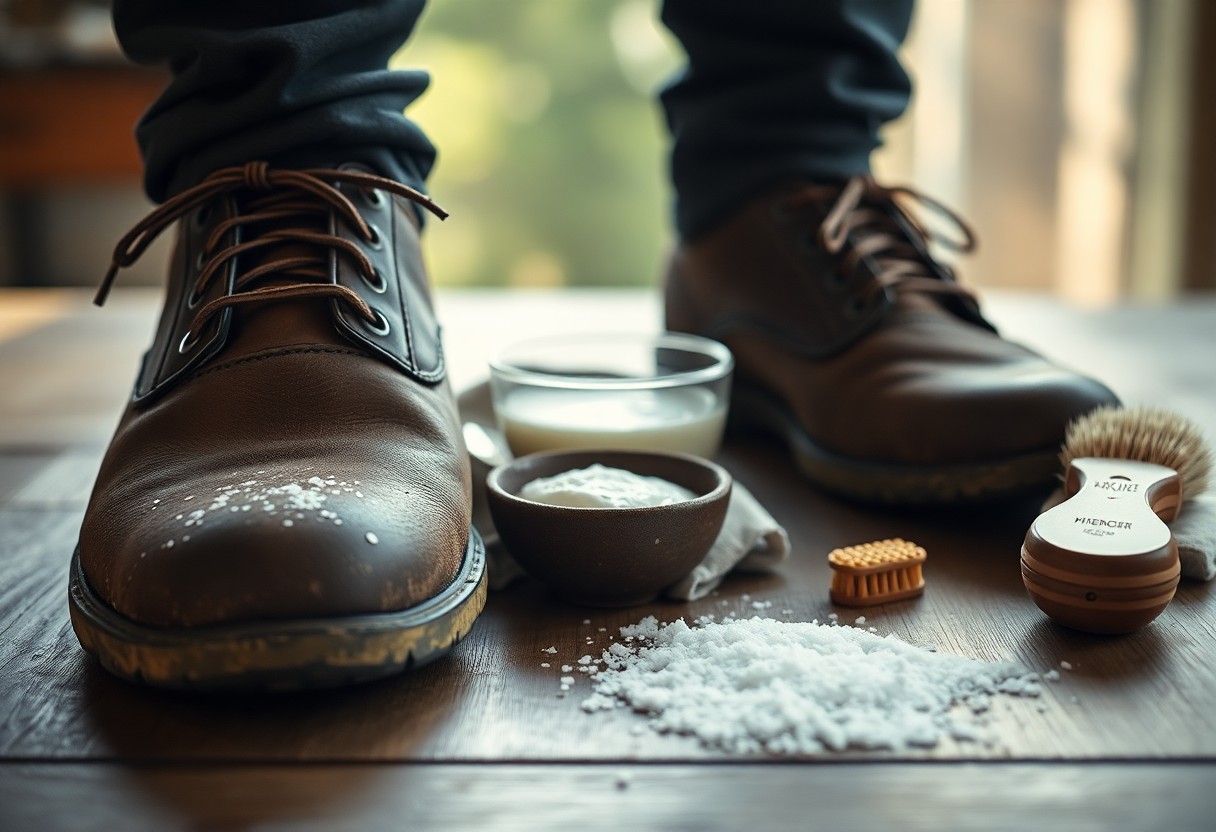
Comprehensive Step-by-Step Guide for Effectively Removing Salt Stains from Shoes
Effectively removing salt stains from your shoes is achievable by following a systematic approach. This detailed process requires careful attention to detail and the right cleaning supplies to ensure successful stain removal without causing harm to the leather. By following a structured cleaning process, you can restore your shoes to their original condition and extend their life.
| Basic Cleaning Items | Advanced Cleaning Items |
| Warm water, Clean cloth, Paper towels | Vinegar, Lemon juice, Leather cleaner |
Basic Techniques for Promptly Treating Fresh Salt Stains on Shoes
Salt stains are most easily managed when treated immediately. Use a clean, damp cloth to gently wipe your shoes from top to bottom, ensuring that you change the cloth section frequently to prevent spreading the salt further onto the leather. This method not only helps in effectively removing the stains but also prevents them from setting in, which could lead to more serious damage over time.
Advanced Techniques for Effectively Tackling Stubborn Salt Stains
- Combine equal parts water, vinegar, and lemon juice in a bowl
- Gently apply the solution using a soft cloth
- Wipe in one direction only to avoid damaging the leather
- Take care to avoid oversaturating the leather during the process
Successfully cleaning stubborn salt stains necessitates a methodical approach. Always remember to test cleaning solutions on a small, hidden area first to confirm they won’t harm your shoes. This precaution ensures that you can safely use the solution without risking damage to the visible parts of your footwear.
| Immediate Care Steps | Long-term Protection Steps |
| Air dry your shoes at room temperature | Apply leather conditioner consistently |
Essential Tools and Recommended Products for Effective Shoe Care
To effectively treat salt stains, you need to have a well-organized cleaning kit at your disposal. Your basic kit should include clean white cloths, a soft brush, paper towels, and a bowl for mixing cleaning solutions. Always keep a designated cloth for cleaning at both home and work to enable a swift response to any salt exposure. This preparedness helps you tackle stains as soon as they happen, minimizing potential damage.
Recommended Cleaning Solutions and Materials for Optimal Shoe Care
The most effective cleaning solutions consist of a mix of equal parts water, vinegar, and lemon juice. Additionally, consider using commercial products like Saphir salt stain remover for enhanced efficacy. Your cleaning kit should also incorporate leather conditioner, shoe cream, and waterproofing spray for post-cleaning care. Avoid harsh chemicals that could potentially damage your shoes during the cleaning process. Opting for gentler, more natural solutions can protect your footwear while still delivering effective results.
Evaluating Professional vs. DIY Cleaning Products for Comprehensive Shoe Care
With a variety of both store-bought and homemade solutions available, you have multiple options for your shoe care routine. Professional products often come with specialized formulations designed for efficiency and ease of use, while DIY solutions utilizing household items can be equally effective and more cost-efficient. The choice between these options ultimately depends on the value of your shoes and the frequency of cleaning required. Consider your specific needs and preferences when making your selection.
Cleaning products differ significantly in their application methods and effectiveness. Professional cleaners typically offer faster results but come at a higher cost. DIY remedies such as the water-vinegar-lemon mixture may demand more time and effort but allow you greater control over the ingredients used. The quality and type of your leather shoes should guide your decision on product selection to ensure you choose the best care method for your needs.
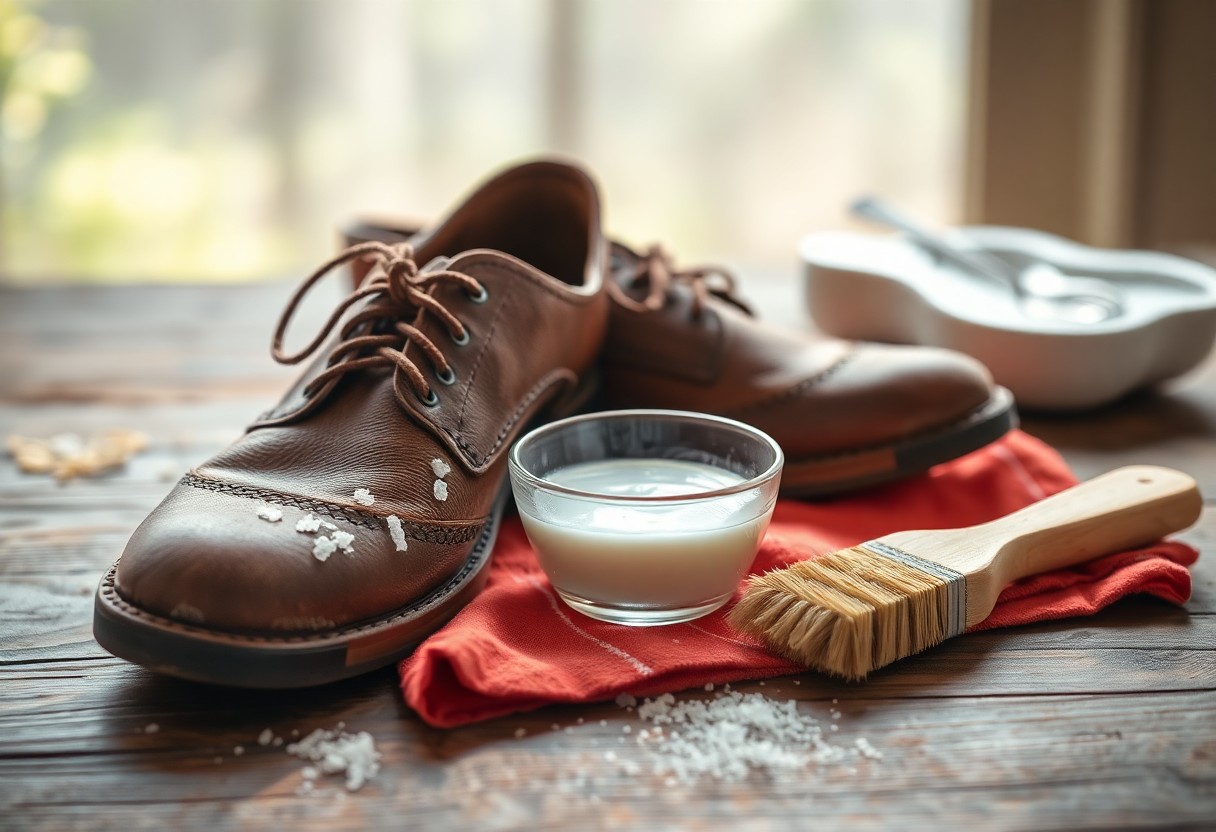
Environmental Factors Affecting Shoe Care During Winter Months
While regional variations exist, salt exposure and leather damage are influenced by a multitude of environmental factors. The challenges faced by your shoes can differ based on location, climate, and the urban infrastructure. Temperature fluctuations, humidity levels, and the type of salt used on roads can all play a significant role in determining the severity of staining. Recognizing these factors empowers you to adapt your protection strategy accordingly for the best results.
Understanding How Weather Conditions Impact Footwear and Salt Damage
The impact of weather conditions on your shoes’ susceptibility to salt damage can vary greatly. When temperatures hover around freezing, wet conditions heighten the risk of salt infiltrating the leather. You are likely to notice more severe staining during freeze-thaw cycles, where temperatures fluctuate drastically between day and night. Your shoes face heightened vulnerability during early spring when melting snow mixes with residual road salt, necessitating extra care during this transitional period. Being aware of these conditions can help you take proactive measures to protect your footwear.
Proper Storage Techniques for Shoes During Winter Months
In the winter season, ensuring your shoes are stored correctly becomes paramount for their protection. You should keep your footwear in a dry environment with stable temperatures, away from direct sources of heat. Regular cleaning after each use is vital to prevent salt buildup, while proper ventilation is necessary to avoid moisture accumulation that could lead to further damage. Effective storage techniques can significantly enhance your shoes’ longevity and performance.
Consistent attention to detail during winter shoe care is essential. Never store damp shoes in closed spaces, as this can trap moisture and accelerate salt damage. It is advisable to maintain a regular cleaning schedule and utilize shoe trees to preserve shape and absorb excess moisture. Applying protective treatments before winter begins will create an effective barrier against salt exposure, ensuring your shoes remain in prime condition throughout the season.
Comparative Analysis of Various Treatment Methods for Salt Stain Removal
To keep your shoes protected, it’s important to select the right treatment method. Below is a comparison of available options to assist you in making an informed decision:
| Commercial Solutions | Home Remedies |
|---|---|
| Fast-acting formulas | Cost-effective alternatives |
| Specialized protection | Made from natural ingredients |
Weighing the Pros and Cons of Chemical-based Solutions for Shoe Care
Utilizing chemical-based solutions offers quick results but requires careful handling and consideration of safety. Here are some factors to weigh:
| Pros | Cons |
|---|---|
| Rapid effectiveness | Higher overall cost |
| Long-lasting protective benefits | Potential use of harsh chemicals |
| Professional-grade results | Possible environmental impact |
| Consistent performance | Specific storage requirements |
Natural Remedies: Evaluating Their Pros and Cons for Effective Shoe Care
While natural remedies may take longer to deliver results, they provide safer alternatives for both your shoes and the environment. Natural solutions, such as vinegar and lemon juice mixtures, offer gentle cleaning action without the risk of harmful chemicals. Although these methods may require more frequent application, they are budget-friendly and easily accessible in most households, making them a practical choice for many shoe owners who prioritize both effectiveness and safety.
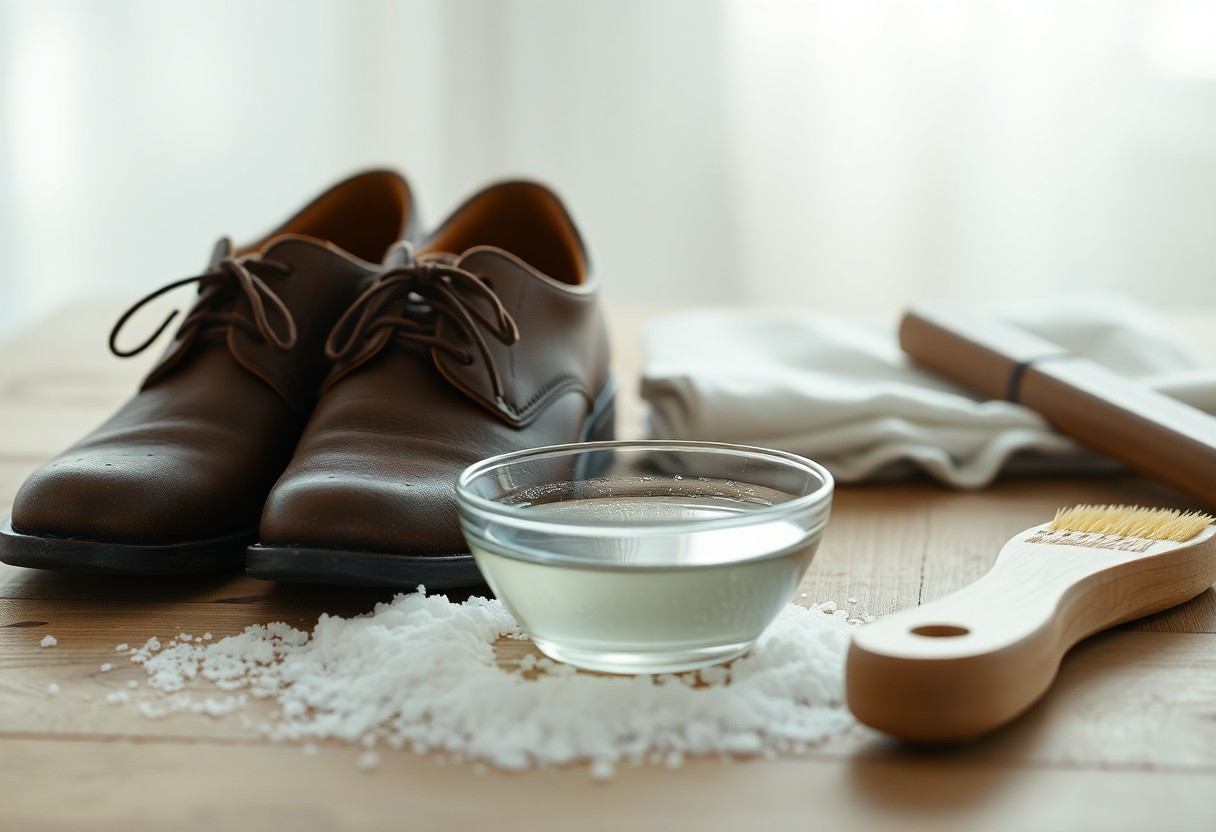
Building a Comprehensive Long-term Care Routine for Your Shoes
To ensure your shoes remain protected against salt damage throughout the year, it is essential to adopt a comprehensive care routine. This routine should include regular waterproofing treatments, deep cleaning at the change of seasons, and appropriate storage during off-seasons. After winter, thorough inspection and restoration of your footwear are crucial for maintaining both durability and appearance. By committing to a detailed care plan, you can extend the life of your shoes and keep them in excellent condition.
Ongoing Maintenance Strategies for Ensuring Long-lasting Shoe Care
Even after successfully removing salt stains, your shoes require ongoing care to prevent future damage. Key maintenance steps include:
- Weekly conditioning of leather surfaces to keep them supple
- Application of protective sprays every month to maintain a barrier
- Storage of shoes with cedar shoe trees to preserve shape and absorb moisture
- Use of protective covers during wet conditions to shield against exposure
After treating salt stains, always allow your shoes to air dry naturally for at least 24 hours to ensure they retain their shape and integrity. This attention to detail in the drying process is vital for the overall health of your footwear.
Creating a Structured Care Routine and Schedule for Footwear Maintenance
Maintaining your shoes should adhere to a structured schedule for optimal care. Clean your shoes after each wear during the winter months, apply protective spray every 4-6 weeks, and perform deep conditioning treatments monthly to keep them in peak condition. Establishing a regular routine can significantly mitigate the effects of salt and moisture on your footwear.
It’s essential to recognize that prevention is better than cure when it comes to salt damage. Your regular care routine should encompass daily wiping, weekly cleaning, and monthly protection treatments. This systematic approach not only extends the lifespan of your footwear but also ensures they maintain their appearance through the challenges of winter conditions.
Essential Takeaways for Protecting and Maintaining Your Shoes During Winter
With these insights, your best strategy against salt damage combines proactive prevention with prompt action. To protect your shoes, make it a habit to wipe them down immediately after exposure to salt, utilizing proper techniques and suitable cleaning solutions. If you notice salt stains, act quickly with a vinegar-water-lemon solution or specialized cleaners. Always follow up with conditioning your leather to restore lost moisture. By implementing these straightforward steps, you’ll be able to keep your shoes looking great and extend their life throughout the winter seasons.
Frequently Asked Questions About Shoe Care Practices
Q: What preventive measures can I implement to protect my leather shoes from salt stains during winter?
A: To prevent salt stains, clean your shoes promptly after exposure to salt using a damp cloth with warm water. Wipe from top to bottom in one direction, changing the cloth section frequently. It’s also beneficial to apply a leather protector before the winter season begins to create an effective barrier against salt damage.
Q: What is the most effective homemade solution for removing existing salt stains from leather shoes?
A: Create a mixture using equal parts water, vinegar, and lemon juice for an effective salt-dissolving solution. Use this mixture with a clean cloth, wiping from top to bottom, and clean the cloth often during the process. After removing the salt, wipe the shoes with plain water using a fresh cloth, then allow them to dry completely before applying leather conditioner.
Q: How can I determine if I have successfully eliminated all salt from my shoes?
A: Check for any remaining white residue on the leather surface; if none is visible, you have likely removed all the salt. Be aware that dark stains may linger even after salt removal. These marks indicate areas where the salt has compromised the leather, but they do not signify active salt presence. Always condition the leather after cleaning to replenish moisture.
The Article Guide to preventing and removing salt stains from shoes effective tips and techniques appeared first on My Shoes Finder
The Article Preventing and Removing Salt Stains from Shoes: Effective Tips Was Found On https://limitsofstrategy.com
References:
Preventing and Removing Salt Stains from Shoes: Effective Tips
Effective Tips for Preventing and Removing Salt Stains from Shoes
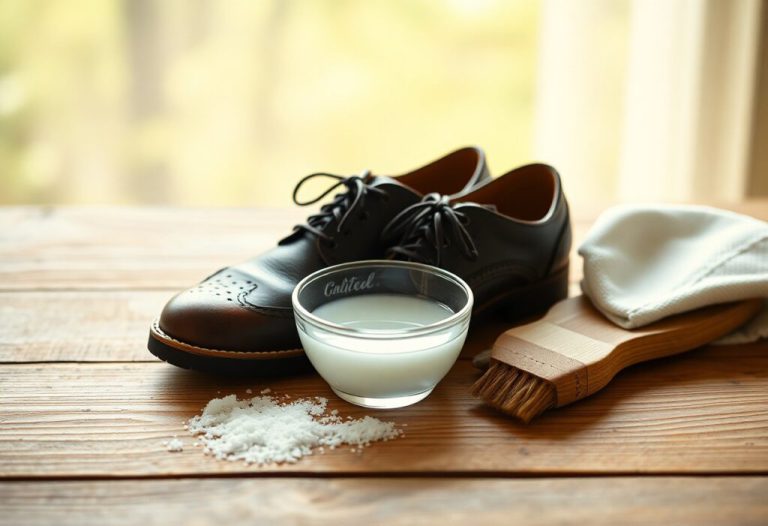




I appreciate the comprehensive approach you’ve taken in addressing the challenges posed by road salt during winter. Your insights into the detrimental effects of salt on footwear resonate deeply with any shoe enthusiast or anyone who values the longevity of their investment.
You bring up a great point about the impact of road salt on footwear. It’s definitely one of those things that doesn’t get enough attention. For most of us, shoes are a significant investment — not just in terms of money, but also in comfort and style. The last thing anyone wants is to see them deteriorate because of a substance we just spread on our roads in the winter.
You make a really insightful point about footwear; it’s often something we don’t think about until it’s too late. Most people invest a decent amount in shoes, not only for how they look but also for the support they provide — comfort really matters, especially during those long winter walks.
You’ve touched on a really important aspect of footwear that often gets overlooked. It’s fascinating how the right pair of shoes can make all the difference during those long winter walks. Many people focus on style, thinking about how their shoes will look with an outfit, but the support and comfort they offer are just as critical.
You’ve hit on something really important with the discussion about footwear. It’s so easy to overlook, but when you think about how much time we spend on our feet, it’s wild that we don’t prioritize what we wear on them more. When those chilly winter walks roll around, the right pair of shoes can make all the difference.
You’ve brought up a really fascinating point about footwear that resonates with so many of us. It’s true—when you think about it, we plaster our feet into all kinds of shoes without really considering the impact it has on our comfort and health. The sheer number of hours we spend standing, walking, or even just moving around in our daily lives really makes you realize how our choice of footwear can become a game-changer.
You’ve really nailed it with that! It’s funny how much attention we give to what drapes over us but often leave our feet hanging out to dry—figuratively, of course, because literally, wet feet in winter is a whole different problem.
It’s interesting how we often prioritize presentation—what’s visible to others—over aspects that really ground us, like our feet. I’ve noticed that too, especially during winter when cozy boots become a fashion statement and yet, we might ignore those subtle signals from our bodies. Wet feet? That can definitely lead to all sorts of discomfort and, even worse, health issues if we’re not careful.
You’ve hit on something really important. Shoes aren’t just a fashion statement; they play a crucial role in how we experience daily life, especially when you’re trudging through slush or icy streets. It’s interesting how we often prioritize style over functionality, only to find ourselves regretting that decision when our feet start complaining halfway through a walk.
You really hit on an important topic. Footwear does play such a crucial role in our daily comfort and overall health, especially during those long winter walks where support is key. I’ve noticed that when I invest in a good pair of shoes, it can make such a difference not just in physical comfort, but also in my mood.
You’ve raised a great point about the importance of footwear; I recently came across some tips that really help make those investments last longer, which might be perfect for those long winter walks.
‘Extend Your Shoes’ Life with These Essential Tips’
https://merrebes.com.au/extend-your-shoes-life-with-these-essential-tips/.
It’s great to hear your perspective on footwear and how it impacts both comfort and mood. It’s interesting how something as simple as a good pair of shoes can shift our experience during those endless winter walks. I completely agree that when we treat our feet well, it can have a ripple effect on our overall well-being.
You’re spot on about footwear often flying under the radar until we’re faced with discomfort. The right pair of shoes can truly transform those long winter walks from a chore into a pleasant experience. Comfort and support are crucial, especially since winter conditions can catch you off guard.
You’re right; it’s easy to overlook our shoes until the first chill hits our toes. Finding the right pair really can switch up those winter walks from a struggle to something enjoyable. I think a lot of people don’t realize how much a good sole can impact their day.
You’re so right about footwear—the impact it has can often go unnoticed until we start feeling discomfort. I’ve definitely found that investing in good shoes pays off during those long winter walks. It’s interesting how much our daily wear can affect not just our comfort but our overall health too. I read somewhere that poor footwear can contribute to issues like back pain or even affect our posture over time.
You’ve hit the nail on the head about footwear. Many people overlook how much our shoes can influence not just our comfort during activities like winter walks but also our overall health. It’s fascinating to think about how something as seemingly simple as a pair of shoes can lead to repercussions like back pain or poor posture over time.
You make such a good point about footwear often flying under the radar until we’re faced with discomfort. It’s surprising how easily we can overlook something so fundamental to our daily lives. Those long winter walks can really take a toll, and having the right shoes can make all the difference.
Footwear really does play a crucial role in our everyday lives, and it’s easy to overlook until discomfort sets in. It’s interesting how the right shoes combine both functionality and style; they can truly elevate our experience during something as simple as a walk. When you think about those long winter walks, having shoes that offer proper support is vital, especially as uneven surfaces and colder temperatures can increase the risk of slips and fatigue.
You’re spot on about how footwear often takes a back seat in our considerations until we feel that pinch. It’s fascinating how much of an impact a good pair of shoes can have on our daily lives. When you think about it, shoes are our first line of defense against the elements, especially during those long winter walks where ice and slush are constant companions.
You’re spot on about footwear often being an afterthought until we start feeling the effects, especially after those long winter walks. I’ve definitely experienced that moment when I realized my shoes weren’t providing the support I thought they did—it’s like a light bulb goes off, and suddenly, comfort becomes a top priority.
You’ve really captured that moment perfectly. It’s amazing how footwear can slip under the radar until we’re reminded, sometimes painfully, about their role in our daily comfort. Winter walks can really do a number on our feet if we’re not careful, can’t they? Cold, wet weather adds a whole new layer of discomfort, and that’s when the realization hits us like a ton of bricks—your shoes aren’t cutting it anymore.
I completely relate to that realization about footwear. It’s amazing how much we take for granted until we’re out on a long trek and suddenly feel that nagging pain in our feet. It’s like our shoes silently fail us, and we’re left wishing we had invested more attention into that choice.
I can relate to that “aha” moment with footwear—it’s funny how we often overlook the basics until they start letting us down; that’s why I found this piece on maintaining travertine tiles super helpful—it’s all about giving our homes the support they need too.
‘Travertine Tile Cleaning: Essential Maintenance Tips’
https://merrebes.com.au/travertine-tile-cleaning-essential-maintenance-tips/.
You really captured a moment that resonates with so many of us. It’s funny how footwear often plays the role of the silent partner in our adventures until it finally shows us just how crucial it is to our comfort and well-being. I can relate to that light bulb moment; sometimes, it takes just one long walk on a cold, biting day to really notice the aches and pains we’ve been ignoring.
It’s nice to find a fellow footwear aficionado who understands the silent battle our shoes face each winter! Road salt can feel like a cruel prank, particularly when you’ve invested in a pair of stylish boots that you intended to show off. You want them to strut down the street like runway models, but salt spray turns your potential catwalk into a treacherous slip-and-slide.
It’s refreshing to connect with someone who truly gets the struggle of maintaining stylish footwear during winter. The impact of road salt can feel maddening, especially when you’ve chosen boots that are not just practical but also a statement piece. You put so much thought into your choice, only to have them face that gritty barrage of salt and grime.
Your insights on protecting footwear during winter resonate strongly with those of us who cherish our shoes. The damage caused by road salt is often underestimated until we notice those frustrating stains or the deterioration of the leather over time. I’ve personally experienced this with my favorite pair of boots; after one winter, they emerged with a cloudy residue that, no matter how much I scrubbed, never fully came off.
It sounds like you’ve had quite the journey with your favorite pair of boots. Those experiences really drive home how essential it is to think about footwear care during the winter months, doesn’t it? It’s surprising how quickly road salt and snow can wreak havoc on our shoes, turning a prized pair into something less than wearable after just one season.
I completely understand your frustration with road salt; it’s one of those issues that can really sneak up on you. The struggle to keep our favorite footwear looking pristine through winter is a real battle. Those stubborn stains and the cloudy residue that seems to cling to leather can feel like a personal attack on our cherished boots.
You’ve hit the nail on the head with that. It’s like our stylish boots suddenly turned into targets for winter warfare. The moment we step outside, it feels like road salt is just waiting to jump on and ruin all our good intentions.